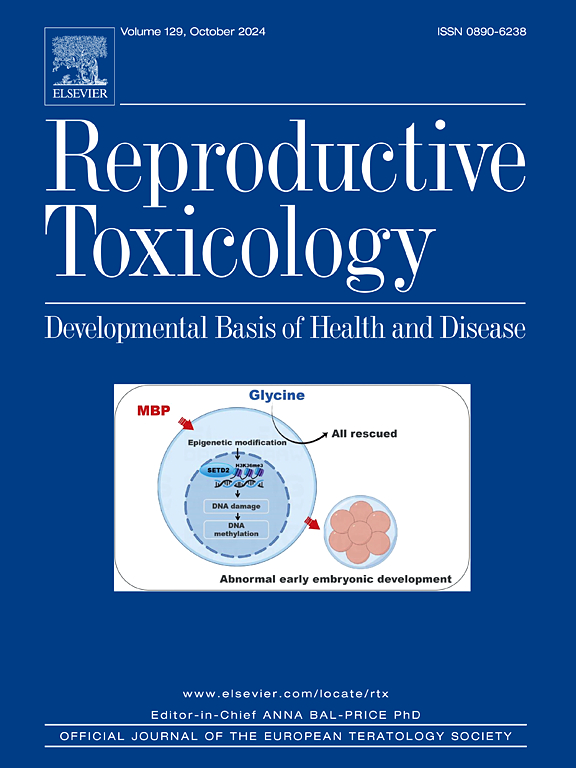氯氰菊酯通过破坏丝裂原活化蛋白激酶(MAPK)途径和钙稳态,引发牛乳腺氧化应激、细胞凋亡和炎症。
IF 3.3
4区 医学
Q2 REPRODUCTIVE BIOLOGY
引用次数: 0
摘要
氰-(3-苯氧苯基)甲基]3-(2,2-二氯乙烯基)-2,2-二甲基环丙烷-1-羧酸酯(氯氰菊酯)是一种拟除虫菊酯类杀虫剂,广泛用于驱虫,如蟑螂和蚂蚁。除目标昆虫外,还概述了其对鲤鱼的危害;老鼠;以及人类的神经系统、生殖系统和肠胃系统。然而,氯氰菊酯对奶牛乳腺组织和产奶量的影响尚不清楚。因此,在本研究中,我们旨在利用牛乳腺上皮细胞(MAC-T)来阐明氯氰菊酯对奶牛的影响,该细胞在产奶量和品质维持中起着关键作用。首先,我们评估了氯氰菊酯对细胞活力、增殖和细胞周期进程的影响,然后进行了相关基因表达分析。氯氰菊酯处理的细胞表现出G1期阻滞和亚G1期数量的增加。氯氰菊酯暴露后,细胞凋亡早期和晚期的MAC-T细胞数量均增加。氯氰菊酯引起线粒体钙超载,使MAC-T细胞线粒体膜电位降低。我们还观察到,在氯氰菊酯暴露的MAC-T细胞中,丝裂原活化蛋白激酶(MAPK)级联被破坏,最终导致细胞凋亡和过度氧化应激。此外,氯氰菊酯还会影响细胞凋亡和炎症相关的转录水平,从而可能导致乳腺炎等临床疾病的发生。本文章由计算机程序翻译,如有差异,请以英文原文为准。
Cypermethrin triggers oxidative stress, apoptosis, and inflammation in bovine mammary glands by disruption of mitogen-activated protein kinase (MAPK) pathways and calcium homeostasis
Cyano-(3-phenoxyphenyl)methyl]3-(2,2-dichloroethenyl)-2,2-dimethylcyclopropane-1-carboxylate (cypermethrin) is a pyrethroid insecticide that is widely used to repel insects, such as cockroaches and ants. In addition to the target insects, its hazards have been outlined for carp; mice; and the nervous, reproductive, and gastrointestinal systems of humans. However, the effects of cypermethrin on the mammary tissue and milk production in dairy cattle remain unknown. Therefore, in the present study, we aimed to elucidate the impact of cypermethrin on dairy cattle using bovine mammary epithelial cells (MAC-T), which play key roles in milk yield and quality maintenance. First, we assessed the effects of cypermethrin on cell viability, proliferation, and cell cycle progression, followed by correlated gene expression analysis. Cypermethrin-treated cells exhibited G1 phase arrest and an increase in the sub G1 population. The population of MAC-T cells in both early and late apoptotic phases was increased following cypermethrin exposure. Moreover, cypermethrin caused mitochondrial calcium overload and diminished the mitochondrial membrane potential in MAC-T cells. We also observed the disruption of mitogen-activated protein kinase (MAPK) cascades and eventually, apoptotic cell death and excessive oxidative stress in cypermethrin-exposed MAC-T cells. In addition, cypermethrin affects the transcription levels related to apoptosis and inflammation, which may lead to the development of clinical morbidities, such as mastitis.
求助全文
通过发布文献求助,成功后即可免费获取论文全文。
去求助
来源期刊

Reproductive toxicology
生物-毒理学
CiteScore
6.50
自引率
3.00%
发文量
131
审稿时长
45 days
期刊介绍:
Drawing from a large number of disciplines, Reproductive Toxicology publishes timely, original research on the influence of chemical and physical agents on reproduction. Written by and for obstetricians, pediatricians, embryologists, teratologists, geneticists, toxicologists, andrologists, and others interested in detecting potential reproductive hazards, the journal is a forum for communication among researchers and practitioners. Articles focus on the application of in vitro, animal and clinical research to the practice of clinical medicine.
All aspects of reproduction are within the scope of Reproductive Toxicology, including the formation and maturation of male and female gametes, sexual function, the events surrounding the fusion of gametes and the development of the fertilized ovum, nourishment and transport of the conceptus within the genital tract, implantation, embryogenesis, intrauterine growth, placentation and placental function, parturition, lactation and neonatal survival. Adverse reproductive effects in males will be considered as significant as adverse effects occurring in females. To provide a balanced presentation of approaches, equal emphasis will be given to clinical and animal or in vitro work. Typical end points that will be studied by contributors include infertility, sexual dysfunction, spontaneous abortion, malformations, abnormal histogenesis, stillbirth, intrauterine growth retardation, prematurity, behavioral abnormalities, and perinatal mortality.
 求助内容:
求助内容: 应助结果提醒方式:
应助结果提醒方式:


